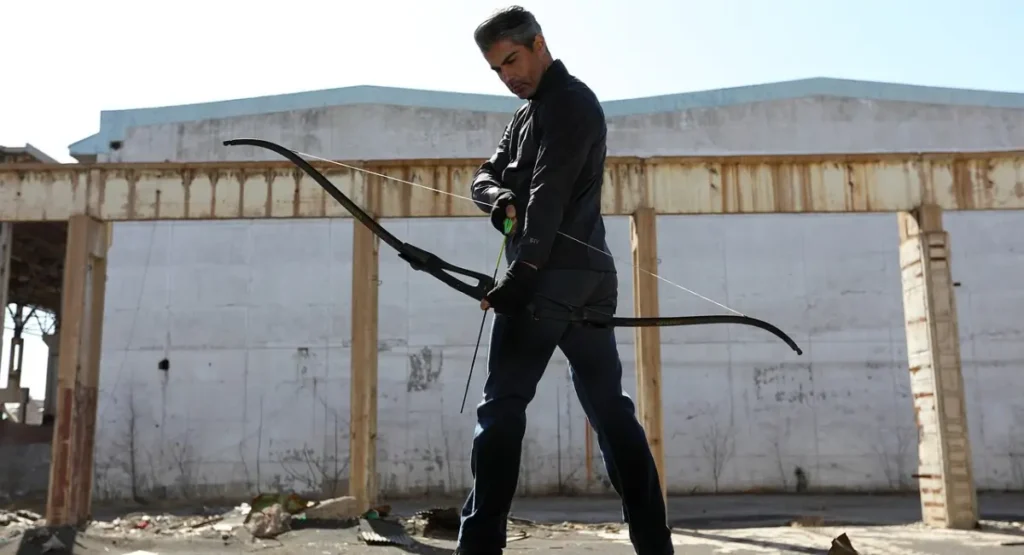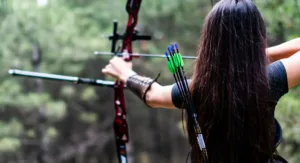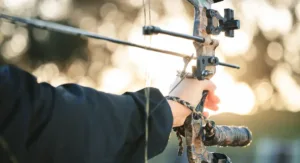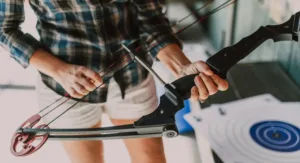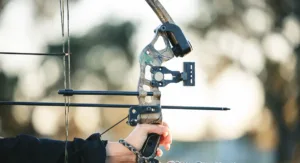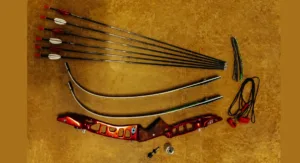Archery is a timeless sport that blends precision, skill, and technique. Whether you’re an archery enthusiast, an outdoor sports fan, or part of the hunting community, understanding the essential parts of a bow can significantly enhance your performance and appreciation of the sport.
In this comprehensive guide, we’ll break down the key components of a bow, providing you with valuable insights, practical tips, and expert advice. By the end of this post, you’ll understand bow anatomy. You’ll know how to maintain your equipment and improve your archery skills.
The Main Parts Of A Bow
Before we dive into the detailed breakdown of each part, let’s start with an overview of the main components of a bow. A typical bow consists of seven essential parts:
- Riser
- Limbs (upper and lower).
- String
- Arrow Rest
- Sight
- Stabilizer
- Nocking Point
Each of these parts plays a crucial role in the bow’s performance and your overall shooting experience.

Riser
The riser is the central part of the bow you hold while shooting. It connects the limbs and houses various components such as the arrow rest, sight, and stabilizer.
Function Of The Riser
The riser serves as the bow’s foundation, providing stability and balance. It also affects the bow’s weight and feel.
Materials Used
Risers are made of aluminum, carbon, or wood. Aluminum risers are lightweight and durable, while carbon risers offer enhanced stiffness and vibration reduction. Wood risers provide traditional feel and aesthetic appeal.
Innovations And Variations
Modern risers come with adjustable features, allowing archers to fine-tune their setup for optimal performance. Some risers also include damping systems to reduce vibrations and improve accuracy.
Limbs
The limbs are the flexible arms of the bow that store and release energy when you draw and release the string.
Upper And Lower Limbs
A bow has two limbs upper and lower. Both limbs work together to generate the force needed to propel the arrow.
Materials And Technological Advancements
Limbs are typically made from laminated wood, fiberglass, or carbon. Advanced materials and construction techniques have led to lighter, stronger, and more efficient limbs.
Importance Of The Limbs
The quality and design of the limbs significantly impact the bow’s performance, including draw weight, speed, and stability.
String
The string connects the upper and lower limbs and propels the arrow forward.
Types Of Strings
There are various types of bowstrings, including Dacron and FastFlight. Dacron strings are durable and forgiving, making them suitable for beginners. FastFlight strings offer higher speed and performance but require more maintenance.
Maintenance Tips
To ensure your bowstring’s longevity, regularly check for signs of wear and tear, keep it waxed, and avoid exposing it to extreme temperatures or moisture.
Arrow Rest
The arrow rest is a small component attached to the riser that supports the arrow in the correct position during draw and release.
Types Of Arrow Rests
Arrow rests come in different types, including fixed and drop-away rests. Fixed rests provide consistent support, while drop-away rests offer better accuracy by reducing contact with the arrow.
Importance Of The Arrow Rest
A well-chosen arrow rest can greatly improve shooting accuracy and consistency.
Sight
The sight is an aiming device mounted on the riser to help archers aim accurately.
Types Of Sights
There are several types of sights, including fixed pin, movable pin, and digital sights. Fixed pin sights have preset distances, while movable pin sights allow adjustments based on the target distance. Digital sights offer advanced features such as rangefinders and electronic displays.
Benefits Of Using A Sight
Using a sight can enhance your accuracy and confidence, especially when shooting at varying distances.
Stabilizer
The stabilizer is an optional accessory that helps balance the bow and reduce vibrations during the shot.
Types And Materials
Stabilizers come in various lengths and materials, including aluminum, carbon, and rubber. The choice of stabilizer depends on your shooting style and preferences.
Benefits Of Stabilizers
A stabilizer can improve shot consistency, reduce hand shock, and enhance stability.
Nocking Point
The nocking point is the spot on the bowstring where the arrow is placed before drawing.
Setting The Notching Point
Properly setting the shooting point ensures consistent arrow placement and accurate shooting. It involves measuring and marking the string to achieve the correct position.
Importance Of The Nocking Point
A correctly set nocking point is essential for consistent and accurate shots.
Additional Parts And Accessories
Apart from the main components, there are several additional parts and accessories that can enhance your archery experience.
Clicker
A clicker helps archers maintain a consistent draw length. It provides an audible signal when the correct draw length is reached, improving accuracy and form.
V-Bar And Side Rods
V-bars and side rods are stabilizer extensions that provide additional balance and stability. They help distribute the bow’s weight evenly, reducing torque and improving shot accuracy.
Peep At Sight
A peep sight is a small aperture installed on the bowstring to aid in aiming. It aligns with the front sight, helping archers maintain a consistent anchor point and improve accuracy.
Expert Opinions And Tips
Insights From Professional Archers
Professional archer and Olympic medalist, Brady Ellison, emphasizes equipment balance.
Finding the right balance in your setup allows for a smoother shot. Everything from the riser to the stabilizer needs to work in harmony to achieve optimal performance.
This perspective highlights how fine-tuning each component can improve accuracy and efficiency in shooting.
Archery Coaches’ Recommendations
Renowned archery coach, Khatuna Lorig, advises beginners to focus first on their grip and stance.
Before you worry about gear, perfect your form. A good grip and stance will improve your accuracy more than any high-end equipment.
Lorig’s experience underscores the notion that archery’s foundational skills should not be overlooked.
Quotes On Mental Focus
Legendary archer, Elizabeth Shoemaker, shares valuable insights into the psychological aspect of the sport:
Archery is as much about mental strength as it is about physical skill. Visualizing your shot before you release can significantly enhance your performance.
Her quote reminds us that concentration and mental preparation play a critical role in shot success.
Maintenance And Care
Proper maintenance and care are crucial for keeping your bow in optimal condition and longevity.
General Tips
Regularly inspect all parts of your bow for signs of wear and tear. Clean and lubricate moving parts, such as the arrow rest and sight, to ensure smooth operation.
Seasonal Maintenance
Adjust your maintenance routine based on the season. For example, during winter, store your bow in a dry, temperature-controlled environment to prevent damage from moisture and extreme cold.
Conclusion
Understanding the essential parts of a bow is fundamental for any archer looking to improve their skills and performance. By familiarizing yourself with each component and its function, you can make informed decisions when selecting and maintaining your bow. Remember to apply the knowledge gained from this guide to your next archery session. Don’t hesitate to explore more resources to enhance your expertise.
Frequently Asked Questions (FAQs)
What Are Parts Of A Bow Called?
The main parts of a bow include the riser, limbs, string, arrow rest, sight, stabilizer, and nocking point.
What Are The Three Parts Of A Bow And Arrow?
The three main parts of a bow and arrow are the bow itself, the bowstring, and the arrow.
What Are The Parts Of A Recurve Bow?
Recurve bow parts include the riser, upper and lower limbs, string, arrow rest, sight, stabilizer, and nocking point.
What Is The Structure Of A Bow?
A bow consists of a riser, upper and lower limbs, string, arrow rest, sight, stabilizer, and nocking point. These components work together to store and release energy for shooting arrows.
What Is The Difference Between A Bow And A Recurve Bow?
A recurve bow has limbs that curve away from the archer when unstrung, providing more power and speed to the arrow. Traditional bows, such as longbows, have straight limbs.
What Are The Main Parts Of A Compound Bow?
The main parts of a compound bow include the riser, limbs, cams or pulleys, cables, string, arrow rest, sight, stabilizer, and nocking point.
By gaining a deeper understanding of bow anatomy and its various components, you can unlock new levels of precision and enjoyment in your archery pursuits. Happy shooting!
Recommended Articles
- The Ultimate Guide To Choosing Between Compound Bow vs Crossbow
- How To Carry A Bow – Tips & Techniques For Archers
- Ultimate Guide To Installing Compound Bow Arrow Rest
- The Ultimate Guide To The Best Archery Brands Of Compound Bows
- How To Utilize Recurve Bow Sights: A Comprehensive Guide
- The Archer’s Craft: Understanding Parts Of Recurve Bow

